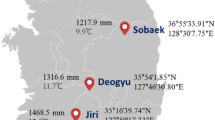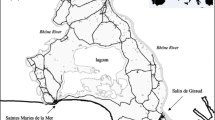Abstract
Sasa borealis, a monocarpic species of dwarf bamboo, is widely distributed throughout Korea. It dominates forest floors, thereby inhibiting mainly the biodiversity. Although it flowers very rarely, examples have recently been observed in multiple locations, providing a good opportunity to study reproduction phenomena, and to aid in biodiversity restoration. Therefore, we investigated the nationwide timing of flowering events by using data collected from a social network service (SNS). We also more closely examined flowering and decline event, focusing at the patch and culm levels on Mt. Jeombong. We then analyzed the main factors affecting flowering. Our SNS and survey results showed that S. borealis is in a current flowering cycle that started in 2013 and continues to the present (83% of all events happening within this period) with a peak in 2015 (48% of the cases occurring in that year). This clearly demonstrated nationwide, synchronized, and massive flowering. Although the culm density in patches was not related to flowering, patches with large culms tended to flower (F = 8.241, p = 0.01). We suspected that this nationwide flowering event was triggered by prolonged drought during the spring months of 2014 and 2015 (F = 5.207, p < 0.05), which led to concurrent, massive flowering in patches mature enough to do so. Because this species prefers a wet habitat, we concluded that severe, prolonged drought induced environmental stress for those plants. After flowering, culms in those particular patches tended to die off within one year. This large-scale synchronized decline should have an enormous effect on the vegetation dynamics of a forest dominated and suppressed by Sasa. Future investigations might incorporate methods of ecological control and manipulation to increase biodiversity there.
Similar content being viewed by others
References
Abe M, Miguchi H, Honda A, Makita A, Nakashizuka T, Harcombe P (2005) Short-term changes affecting regeneration of Fagus crenata after the simultaneous death of Sasa kurilensis. J Veg Sci 16:49–56
Abe Y, Shibata S (2012) Spatial and temporal flowering patterns of the monocarpic dwarf bamboo Sasa veitchii var. hirsuta. Ecol Res 27:625–632
Abe Y, Shibata S (2014) Flower and seed production in a series of flowerings from sporadic events before to after mass flowering of the dwarf bamboo Sasa veitchii var. hirsuta. J For Res 19:268–275
Barbour MG, Burk JH, Pitts WD, Gilliam FS, Schwartz MW (1999) Terrestrial Plant Ecology, Banjamin/Cummings, Menlo Park
Cerny T, Dolezal J, Janecek S, Srutek M, Valachovic M, Petrik P, Altman J, Bartos M, Song JS (2013) Environmental correlates of plant diversity in Korean temperate forests. Acta Oecol 47:37–45
Corp IBM (2013) IBM SPSS Statistics for Windows, Version 22.0. IBM Corp, Armonk
Franklin DC (2004) Synchrony and asynchrony: observations and hypotheses for the flowering wave in a long—lived semelparous bamboo. J Biogeogr 31:773–786
Gielis J, Goetghebeur P, Debergh P (1999) Physiological aspects and experimental reversion of flowering in Fargesia murieliae (Poaceae, Bambusoideae). Syst Geogr Pl 68:147–158
Hayashi T (2010) Flowering and fruiting of Sasamorpha borealis around the Okutama Mountain Region in 2009~2010 and other Sasa group. Fuji Takerui Shokubutsuen Hokoku 54:45–54 (in Japanese)
Hiura T, Sano J, Konno Y (1996) Age structure and response to finescale disturbances of Abies sachalinensis, Picea jezoensis, Picea glehnii, and Betula ermanii growing under the influence of a dwarf bamboo understory in northern Japan. Canadian J For Res 26:289–297
IBM SPSS (2013) IBM SPSS Statistics for Windows, Version 22.0. IBM Corp, Armonk
Igarashi B (1977) Flowering, fructification and death of Sasa kurilensis in the Ishikari district of Hokkaido in 1975. Trans 88th Mtg Jap For Soc 215–217 (in Japanese)
Ishii HT, Kobayashi T, Uemura S, Takahashi K, Hanba YT, Sumida A, Hara T (2008) Removal of understory dwarf bamboo (Sasa kurilensis) induces changes in water-relations characteristics of overstory Betula ermanii trees. J For Res 13:101–109
Janzen DH (1976) Why bamboos wait so long to flower. Annu Rev Ecol Syst 7:347–391
Kawamura S (1927) On the periodical flowering of the bamboo. Jpn J Bot 3:335–342
Kim HC (2009) Ecological characteristics and management methods of Sasa quelpaertensis Nakai. Ph.D. thesis. Jeju National University, Jeju (in Korean)
Korea Communications Commission (2013) Survey on Smart Phone Utilization in the Second Half of the Year 2012. Korea Communications Commission, Gwacheon (in Korean)
Korea Meteorological Agency (2016) www.kma.go.kr.
Korea National Arboretum (2014) Geography and Vegetation of Mt. Jumbong Experimental Forest. Korea National Arboretum, Pocheon (in Korean)
Kudo H (1985) Natural withering of Sasa kurilensis and regeneration of trees. Res Bull Coll Experiment For Hokkaido University 42:899–908 (in Japanese)
Kudoh H, Ujiie M (1990) Regeneration of Sasa kurilensis and tree invasion after mass flowering. Bamboo J 8:38–49
Lee TB (2003) Coloured Flora of Korea(II). Hyangmunsa, Seoul (in Korean)
Lee K (2015) Classification of forested vegetation and successional development in the Central-Eastern Korean Peninsula. Ph.D. thesis. Kangwon National University, Chuncheon (in Korean)
Lee WT, Lim Y (2002) Plant Geography. Kangwon National University Press, Chuncheon (in Korean)
Lowrie AG (1900) Effects of the late drought in the Chanda District. Indian For 26:504–506
Macroembrain (2012) Internet cafe and community tracking. Research report 2012:302–322 (in Korean)
Makita A (1992) Survivorship of a monocarpic bamboo grass, Sasa kurilensis, during the early regeneration process after mass flowering. Ecol Res 7:245–254
Makita A (1998a) The significance of the mode of clonal growth in the life history of bamboos. Plant Species Biol 13:85–92
Makita A (1998b) Population dynamics in the regeneration process of monocarpic dwarf bamboos, Sasa species, In Cheplick GP, ed, Population Biology of Grasses. Cambridge University Press, Cambridge, pp 313–332
Makita A, Konno Y, Fujita N, Takada Ki, Hamabata E (1993) Recovery of a Sasa tsuboiana population after mass flowering and death. Ecol Res 8:215–224
Makita A, Makita H, Nishiwaki A (1995) Mass flowering of Sasa kurilensis to the south of Lake Towada, northern Japan, in 1995. Bamboo J 13:34–41 (in Japanese)
Mun J, Lee D (2015) Drought status of multi-purpose dam using year 2014 and 2015 water supply capacity index. J Korean Water Resour Assoc 48:51–57 (in Korean)
Muroi H (1966) Factors of bamboo flowering following the predation by voles. Reports of Fuhi Bamboo Garden 11:7–38 (in Japanese)
Muroi H (1968) Flowering of S. kurilensis in Mt. Hyono-yama. Reports of Fuji Bamboo Garden 13:90–106 (in Japanese)
Nadgauda R, Parasharami V, Mascarenhas A (1990) Precocious flowering and seeding behaviour in tissue-cultured bamboos. Nature 344:335–336
Nakashizuka T (1988) Regeneration of beech (Fagus crenata) after the simultaneous death of undergrowing dwarf bamboo (Sasa kurilensis). Ecol Res 3:21–35
Nakashizuka T (1991) Population dynamics of coniferous and broadleaved trees in a Japanese temperate mixed forest. J Veg Sci 2:413–418
Narukawa Y, Yamamoto S (2002) Effects of dwarf bamboo (Sasa sp.) and forest floor microsites on conifer seedling recruitment in a subalpine forest, Japan. For Ecol Manage 163:61–70
Numata M (1962) Ecology of bamboo forest. Jpn J Ecol 12:32–40
Numata M (1970) Conservation implications of bamboo flowering and death in Japan. Biol Conserv 2:227–229
Numata S, Yasuda M, Okuda T, Kachi N, Noor NS (2003) Temporal and spatial patterns of mass flowerings on the Malay Peninsula. Am J Bot 90:1025–1031
Oshima Y (1961) Ecological studies of Sasa communities. I. Productive structure of some of the Sasa communities in Japan. Bot Mag Tokyo 74:199–210
Park M, Jang S, Kim S (2015) Analysis of 2015 drought in Korea using real-time drought index. J Korean Soc Hazard Mitig 15:451–458 (in Korean)
Saitoh T, Seiwa K, Nishiwaki A (2002) Importance of physiological integration of dwarf bamboo to persistence in forest understorey: a field experiment. J Ecol 90:78–85
Sakai S, Harrison RD, Momose K, Kuraji K, Nagamasu H, Yasunari T, Chong L, Nakashizuka T (2006) Irregular droughts trigger mass flowering in aseasonal tropical forests in Asia. Am J Bot 93:1134–1139
Seifriz W (1950) Gregarious flowering of Chusquea. Nature 165:635–636
Suyama Y, Suzuki J, Makita A (2010) For the comprehension of gregarious flowering in bamboos. Jpn J Ecol Soc 60:97–106 (in Japanese)
Suzuki S (1978) Index to Japanese Bambusaceae. Gakken, Tokyo, pp 1–384
Takahashi K, Uemura S, Suzuki J, Hara T (2003) Effects of understory dwarf bamboo on soil water and the growth of overstory trees in a dense secondary Betula ermanii forest, Northern Japan. Ecol Res 18:767–774
Tanaka R (1956) Fluctuations in vole populations following the wide spread synchronous flowering of bamboo grasses on Mt. Turugi. Bull Kochi Women’s Coll 4:61–68
Toyooka H, Sato M, Ishizuka S (1983) Distribution Map of the Sasa Group in Hokkaido, Explanatory note. Forestry and Forest Products Research Institute, Hokkaido Branch, Sapporo (in Japanese)
Troup RS (1921) The Silviculture of Indian Trees, Vol 1. Clarendon Press, Oxford
Uchimura E (1974) On the mass flowering of Sasa kurilensis. Reports of Fuji Bamboo Garden 19:33–38 (in Japanese)
Yamamoto S, Nishimura N, Matsui K (1995) Natural disturbance and tree species coexistence in an old-growth beech-dwarf bamboo forest, southwestern Japan. J Veg Sci 6:875–886
Yamazaki K, Nakagoshi N (2005) Regeneration of Sasa kurilensis and tree invasion after sporadic flowering. Bamboo J 22:93–103
Yuruki T, Ohga S, Aragami K (1987) Ecological studies of suzutake (Sasa borealis), 4: Individual growth and photosynthesis. Bull Kyushu Univ For 57:9–15
Author information
Authors and Affiliations
Corresponding author
Rights and permissions
About this article
Cite this article
Cho, S., Lee, B. & Choung, Y. Rare nationwide synchronized massive flowering and decline event of Sasa borealis (Hack.) Makino in South Korea. J. Plant Biol. 60, 423–430 (2017). https://doi.org/10.1007/s12374-017-0094-z
Received:
Accepted:
Published:
Issue Date:
DOI: https://doi.org/10.1007/s12374-017-0094-z




